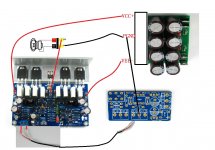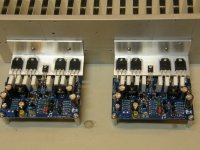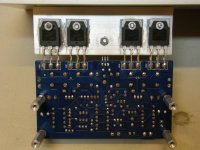I just finished assembling my L20 V9.2 kit today and instead of using the d1047/b817's that came with it I used Hitachi 2sa753/2sc1343 TO3's. I had them already mounted in a heat sink from an old 1977 Hitachi amp I took apart.
I wired it all up and using a light bulb started it up on +47-0- -47 and it worked no problem. Sound was good as far as I can tell as I was using a low pass active sub filter and on a 2R load to boot!
I wired it all up and using a light bulb started it up on +47-0- -47 and it worked no problem. Sound was good as far as I can tell as I was using a low pass active sub filter and on a 2R load to boot!
I just finished assembling my L20 V9.2 kit today and instead of using the d1047/b817's that came with it I used Hitachi 2sa753/2sc1343 TO3's. I had them already mounted in a heat sink from an old 1977 Hitachi amp I took apart.
I wired it all up and using a light bulb started it up on +47-0- -47 and it worked no problem. Sound was good as far as I can tell as I was using a low pass active sub filter and on a 2R load to boot!
GOOD. The output transistor compatible.
I have both of these and I find that the L25 sound better. The L25D has a harsher sound in the upper highs. Also the L25's will handle a 2R load at +50-0- -50 dc. I'm unable to run a 4R load on my L25d's at all after about 50watts, they go into protection mode. A 6R load is marginally better and I can max them into 8R no problem.
hello.
anybody knows which sound better l25 or l25d?
L25 L25D their corresponding analog amplifier, digital amplifier.
L25 need larger radiator, this is more complicated in production. But the larger the radiator will be more stable.
L25 is combined type amplifier. It has a lot of volume.
And there is a wide voltage range L25. 30 to 70 v + -.
I have both of these and I find that the L25 sound better. The L25D has a harsher sound in the upper highs. Also the L25's will handle a 2R load at +50-0- -50 dc. I'm unable to run a 4R load on my L25d's at all after about 50watts, they go into protection mode. A 6R load is marginally better and I can max them into 8R no problem.
B: yes. High power amplifier. I'm still in the design.
It will be to analog amplifier. Hope there will be soon.
Analog amplifier, class AB. It is still the most stable performance.
If the amp is ok and i get noise in the mid range..What is the problem?
8khz-16khz
You can try. Only by one try the power amplifier circuit board.
Share the power interference can be ruled out.
HI!
I ordered L20VER7 and L20VER9 kits.
Does anybody have schematics for them?
Do they run properly with +/-70V?
Are the insulators for the power transistors included?
Thx!
VER7 VER9 + -70V OK.
ljm_ljm,
Can you please advise on this issue? I finished putting together the L20 V9.2 boards, and only one channel works. The right channel, without any load, heats up very quickly, even though it's only powered by 36 volts rails, so the board has some fault that I can't detect. This is the second board that's doing this, so I'm having a lot of trouble building a stereo set. This is my 5th amp, so I know how to solder and build amps. I don't know what type of quality control goes into your process, but I had to buy 3 L7 boards to get 2 good ones, and the same crap is happening with the L20 boards. By the way, I got these from zoe_tsang.
Can you please advise on this issue? I finished putting together the L20 V9.2 boards, and only one channel works. The right channel, without any load, heats up very quickly, even though it's only powered by 36 volts rails, so the board has some fault that I can't detect. This is the second board that's doing this, so I'm having a lot of trouble building a stereo set. This is my 5th amp, so I know how to solder and build amps. I don't know what type of quality control goes into your process, but I had to buy 3 L7 boards to get 2 good ones, and the same crap is happening with the L20 boards. By the way, I got these from zoe_tsang.
Attachments
You have bias problem think. I had to add a pot to the circuit.
Can you please share how you did it? Thanks.
L20V9
Make sure there is no electrical connection to the heat sink bracket as in transistor legs touching or missing/punctured heat sink washers. Watch out for long DC leads and speaker leads dangling close to the PCB. Having built several of these I have had similar problems and it usually indicates one or more of the output devices has fried. Once you get them going they sound very good. I have used 73V DC rails but settled on 56V's. My PCB's were purchased already assembled, all I needed to do was fit to heat sinks and connect PS etc.
Make sure there is no electrical connection to the heat sink bracket as in transistor legs touching or missing/punctured heat sink washers. Watch out for long DC leads and speaker leads dangling close to the PCB. Having built several of these I have had similar problems and it usually indicates one or more of the output devices has fried. Once you get them going they sound very good. I have used 73V DC rails but settled on 56V's. My PCB's were purchased already assembled, all I needed to do was fit to heat sinks and connect PS etc.
David,
I do religious continuity testing after mounting the MOSFETs on the heatsink, so I'm quite sure that they don't touch at all. The legs are bent so there are at least a 2mm gap from the heatsink. I may have to resort to buying assembled boards, but this is upsetting me to no end, when you can't control what is sold to you. I can see from this thread that people are working around the problems, when ljm_ljm should be providing the solutions. Thanks for your help.
Hong
I do religious continuity testing after mounting the MOSFETs on the heatsink, so I'm quite sure that they don't touch at all. The legs are bent so there are at least a 2mm gap from the heatsink. I may have to resort to buying assembled boards, but this is upsetting me to no end, when you can't control what is sold to you. I can see from this thread that people are working around the problems, when ljm_ljm should be providing the solutions. Thanks for your help.
Hong
I bought one unassembled and after mounting to a heatsink I used a multi meter set to short test and tested all transistor legs to heat sink to make sure there was no contact.
Are all the transistors getting hot at the same time or just one?
Before assembly I tested every transistor to make sure none were duds.
Are all the transistors getting hot at the same time or just one?
Before assembly I tested every transistor to make sure none were duds.
- Home
- Amplifiers
- Solid State
- L20 V8


